2009 Civil War Travelogue (part 4)
| Here is a reminder about the reason I write these pages the way I do. They record my experiences and impressions of Civil War trips primarily for my future use. Thus, they sometimes make assumptions about things I already know and focus on insights that I receive. They are not general-purpose descriptions for people unfamiliar with the Civil War, although I do link to various Wikipedia articles throughout. Apologies about the quality of interior photographs—I don't take fancy cameras with big flashes to these events. If you would like to be notified of new travelogues, connect to me via Facebook. |
West Coast Civil War Conference, October 23-25, 2009
I attended the 25th annual conference of the West Coast Civil War round tables in Clovis, California (near Fresno). This was my second time in Clovis, where there is an excellent facility for this type of conference in the Veterans Memorial Building. Since it is only a three-hour drive from my home in Redwood City, this is a very convenient place, with a hotel directly across the street. Clovis is a modest, quaint town with a lot of antique shops, although I didn't spend any time in town on this trip because the agenda was really chock-full of back-to-back sessions, probably the most densely scheduled conference I have ever attended. And that is a good thing!
The theme for this conference was The Campaign for Chattanooga, June-November 1863, and they assembled a very impressive group of historians and National Park Service personnel who traveled to California for the event. My work on Wikipedia has covered all of the actions of this campaign, although I classify it into three separate campaigns: Tullahoma, Chickamauga, and Chattanooga.
Friday, October 23
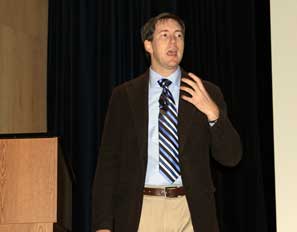 |
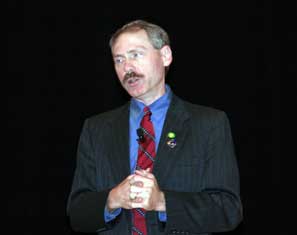 |
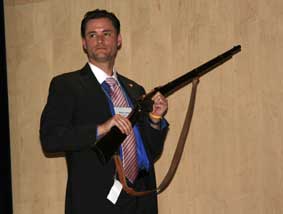 |
Christopher Young |
Jim Ogden |
Evan Jones |
The first presentation—Tullahoma, Chickamauga and Beyond: John Thomas Wilder and His Lightning Brigade—was by Christopher Young, a seasonal ranger at Chickamauga and Chattanooga National Military Park (hereafter referred to as CCNMP). I have never encountered Christopher before, but I was very impressed. He's a very young guy, but exceptionally well spoken and a very smooth presenter. He used PowerPoint slides very effectively with some period photographs and period maps. He also used one of my Wikipedia maps about the early stages of the Chickamauga Campaign, which is always gratifying. (At the end of the presentation, the conference organizer, Evan Jones, identified me to the audience and mentioned the map. My own little corner of fame! Evan knew me from last year's conference because I seemed to be one of the only people taking photographs that he could use to advertise this year's conference. He asked me in advance to take a lot of pictures and share them with him, so I brought Nancy's Canon Rebel XTi digital SLR in the hopes of improving the quality of the photographs. And Rebels are always good for Civil War conferences. The full set of photographs I took are in this gallery.) This was a pretty interesting presentation and Col. John T. Wilder is certainly a unique character of the war. He covered the formation of the Lightning Brigade, described how they reluctantly learned to ride horses and mules, how they acquired Spencer repeating rifles, and then went over the tactical activities at the Battle of Hoover's Gap, the Second Battle of Chattanooga, and the actions on September 18 at Alexander's Bridge at Chickamauga. Something that I did not know about Wilder at the time was that he suffered from frequent bouts of dysentery and had to be transported in an ambulance to a number of his actions.
After a buffet dinner, we had a few welcoming remarks by Dr. Brian Clague and Evan Jones. Evan made an impassioned plea about battlefield preservation and the retention of professional historians and seasonal rangers at National Park Service parks.
 |
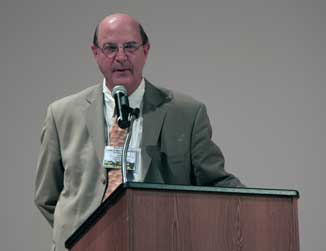 |
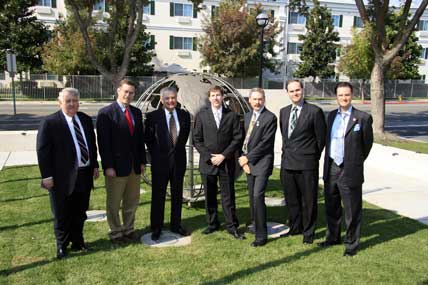 |
Dinner |
Dr. Brian Clague |
Speakers |
The after dinner speaker, a position that no speaker relishes, I'm sure, was Jim Ogden, the chief historian at CCNMP. I first met Jim in 2005 on a Blue and Gray Education Society staff ride of the Stones River battlefield and I wrote up a rather petulant complaint about him keeping us outside listening to lengthy Official Records accounts in sub-freezing weather, so I am reluctant to interact with him much in case he read my travelogue and holds a grudge. :-) He gave a presentation entitled "I Think the Rebellion Must Dwindle and Die": The Strategic, Economic, and Political Importance of Chattanooga in the American Civil War, which was a lengthy explanation of the logistical considerations of manufacturing and supply in the Confederacy. He explained how most of the critical "military-industrial complex" of the South ended up being located in central Georgia and Alabama, protected from the North by the end of the Appalachian Mountains. The 1863 campaigns for Chattanooga were directly responsible for eventually putting these factories out of business in 1864-65. In the specific area of Chattanooga, he explained that the Confederacy lost a great deal of potassium nitrate production capability from the local mountain caves, as well as the most critical metal resource, copper (which was used for many artillery barrels, but most importantly for rifle percussion caps). I thought about asking one of my traditional smart aleck questions—What were the battles or campaigns that were actually lost by the Confederacy due to a lack of supplies or ammunition?—but I decided against it. Sometimes smart aleck questions get smart aleck replies. :-) Jim gave a good, animated talk, unburdened by modern affectations such as PowerPoint, which had not been invented by 1865.
Saturday, October 24
Saturday was really chock-full, keeping us busy nonstop from 8 AM to 9 PM.
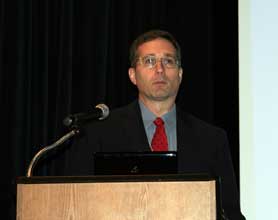 |
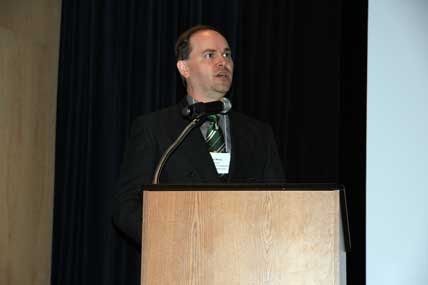 |
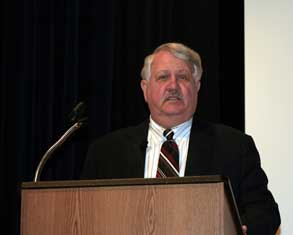 |
Steven E. Woodworth |
Lee White |
William Glenn Robertson |
Steven E. Woodworth, the noted historian of Western Theater topics from Texas Christian University, gave the conference's keynote lecture entitled Rosecrans' Victory March and the Road to Chickamauga. Dr. Woodworth had a number of interesting opinions to share and provided me some new insights. The talk spent some time on Rosecrans's background before these campaigns. He said that Rosecrans occupied a bad position at Corinth and that when the Confederates attacked he panicked and ordered his soldiers to destroy their trains in preparation for a retreat, an order that most did not pay any attention to. He said that Rosecrans was a general who did not know the value of time in warfare. In describing the principal subordinates during these campaigns, he described Alexander McCook as a chucklehead and Thomas Crittenden as a better general, but since he was the only non-West Point graduate among the corps commanders, he was a lonely guy. Woodworth described himself as the foremost defender of Braxton Bragg, a position he was able to defend in a later session. He described the Army of Tennessee senior staff as a snake pit. Leonidas Polk never showed deference to any superior below the rank of God. He pointed out that the six week delay following the Tullahoma Campaign, regardless of its logistical justification, allowed Bragg to obtain numerical superiority over the Union Army at Chickamauga. Woodworth used my Wikipedia map of the Tullahoma campaign and early movements in the Chickamauga campaign in his talk.
Lee White, a park ranger at CCNMP, spoke on Clash at the River of Death, Chickamauga Day One. (Note that in my article on the Battle of Chickamauga, I show that the word does not really mean river of death, but it sure sounds cool.) Unfortunately, just as our pal Rosecrans suffered from a gap on day two, the conference suffered from a gap today. Dr. Woodworth essentially ended his talk as Rosecrans was starting to cross the Tennessee River and no one was around to cover what happened from then up until the start of the battle on September 19, which was really quite a lot, including the risky Union advance on three separate axes, the near disaster at McLemore's Cove, the frantic attempts to consolidate the Union Army, and the minor combat activities on September 18. So Lee jumped directly into brigade-level battle details on September 19, and the lack of context was really quite difficult. We had no idea what Bragg's plans were, what was the disposition of forces, etc. Lee showed a number of slides of the modern battlefield along with his talk. I will have to say that although the Chickamauga battlefield is an interesting place to visit, virtually none of that interest comes through in photographs. All you can see is essentially flat fields, woods, and the occasional minor hill. One interesting remark that Lee made was that Brig. Gen. August Willich was a former associate of Karl Marx, but the latter dismissed him as being too radical! During a Q&A for Woodworth and White, both were critical of the actions of Nathan Bedford Forrest and Patrick R. Cleburne during the first day of battle, which is interesting because of the great regard that military historians have for them later in their careers. Woodworth was also critical of the Confederate cavalry for not imparting knowledge of George H. Thomas's position to Bragg.
Dr. William Glenn Robertson, the director of the Army's Combat Studies Institute at Fort Leavenworth, spoke on the Confederate Breakthrough, Chickamauga Day Two. This was really a talk in two parts. In the first part, he gave an explanation of the history of the staff ride concept, which was originated at Fort Leavenworth in 1906 and lasted until 1911. Robertson was responsible for restarting the program in 1983. (I am a personal fan of staff rides and readers of this website will know that I have taken a few with the Blue and Gray Education Society.) The second part of the talk was about the mystery of how Rosecrans allowed the gap to open up in his line, which Longstreet was able to exploit by coincidence. Robertson's research has determined that the conventional wisdom is wrong. The traditional story is that Brig. Gen. Thomas J. Wood was reprimanded by Rosecrans and, in a subsequent fit of pique, he somewhat maliciously obeyed Rosecrans's order to the letter, even though he knew he was opening up a terribly risky gap in the line. He was quoted as saying something to the effect of "I have the fatal order right here and I will not give up possession of it for $5000!" Robertson traced this story to Henry M. Cist's 1882 book on the Army of the Cumberland, which attempted to build up Rosecrans's reputation by vilifying Wood and Major Bond, the officer who wrote out Rosecrans's order. Another book, by E. V. Westrate, Those Fatal Generals, recounted the incident and manufactured a lot of the dialogue that is nowwidely accepted as being authentic. These two works were used by Glenn Tucker in his 1981 book about the battle and the story has stuck. However, Robertson has uncovered material from Woods that rebuts this these claims and establishes that Chief-of-Staff James A. Garfield was aware of the wording of the order and that Thomas Crittenden, the corps commander, was aware of it as well. Furthermore, when Wood asked Alexander McCook on his opinion about the order, that senior officer counseled him to obey it, saying that he would send Phil Sheridan's division to take up Wood's place in line before he departed. Robertson is working on a book about Chickamauga and is keeping the specific details of Wood's rebuttal a secret until publication.
Christopher Young spoke on William Oates and William Lytle — Bloody Crossroads at Chickamauga. This presentation was well delivered and covered some interesting background biography of both Oates and Lytle, although I did not get the compelling reason of why the two of them were being highlighted in the same talk. Yes, they both fought in the same battle, but it's not like they fought a duel against each other.
Wiley Sword and Steven Woodworth conducted a debate on The Generalship of Braxton Bragg. Wiley presented the "case for the prosecution," taking the negative view of Bragg's performance. He said that although Bragg maintained excellent discipline in his army, he bungled Perryville and squandered his attacks piecemeal at the Hornet's Nest of Shiloh. He probably would have been a more effective staff officer or Inspector General than an army commander. Steve acknowledged that Bragg was not a great general, but he was "serviceable." He asserted that although Bragg was widely disliked, there were a number of his subordinates who actually liked him, giving no details. To accusations that Bragg overused frontal assaults, he stated that all generals in the Civil War conducted frontal assaults and some of them actually succeeded. He made brilliant use of the railroad for strategic purposes in his Kentucky campaign from Tupelo, Mississippi. Steve laid some of the blame for Bragg's performance on Jefferson Davis, who should have realized that some otherwise reasonable people simply cannot cooperate with each other and he should have assisted Bragg in weeding out his rebellious subordinates. He faulted Bragg for not being able to influence Jefferson Davis in the way that Robert E. Lee was able to do (and that Grant was able to do with Lincoln), but also that he was not able to make friends of his own subordinates. (Steve was not applying a very vigorous defensive case on Bragg's behalf.)
Evan Jones, who organized the conference, gave a talk entitled Rosecrans and His Enemies — The Federal High Command and the Campaign for Chattanooga. Evan obviously feels strongly about certain matters and descended into some rather lurid language, such as describing Charles A. Dana as the Iago of the staff and a "loathsome pimp." (That latter phrase was apparently a quote, although he used it himself without attribution earlier in the presentation. He contends that Dana was the architect of the stories about Rosecrans's allegedly debilitated condition after his defeat at Chickamauga and that these stories had no basis in fact. He also described Grant's arrival on the scene in Chattanooga, referring to the staff having rowdy parties with excessive drinking. He implied, although did not state directly, that Grant participated. He made additional negative references to Col. Clark Lagow on Grant's staff; this is a guy with whom I have had no familiarity, so I will attempt to check him out.
William Glenn Robertson returned for a presentation entitled Bull of the Woods? James Longstreet in the Western Theater. I think that this was easily the most focused and best organized presentation of the conference, in which Dr. Robertson really lambasted Longstreet. He said (humorously) that as a Virginian he of course held a grudge against Longstreet for his performance at Gettysburg, but laid those feelings aside in his analysis of Chickamauga. Longstreet is usually praised for his tactical formation at Chickamauga, but Dr. Robertson demonstrated that it occurred almost by accident and that Longstreet did not get up early enough on September 20 to determine the tactical situation or the positions of his neighboring units. To those historians who suggests that Longstreet "perceived the opportunity" of the opening in the Union line, Robertson said that was simply not possible. Longstreet was unprepared for his successful assault and did not keep up the pressure. He launched entirely too many piecemeal attacks on Horseshoe Ridge and did not probe the flanks of the Union position or recognize that there was a half mile gap in the Union line well after the major assault took place. He described the Union position on Horseshoe Ridge as being stronger than that of Cemetery Ridge at Gettysburg, which Robert E. Lee has been so rightly criticized for assaulting.
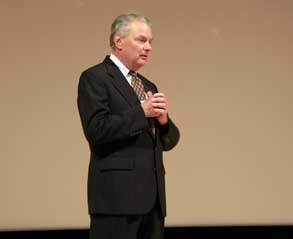 |
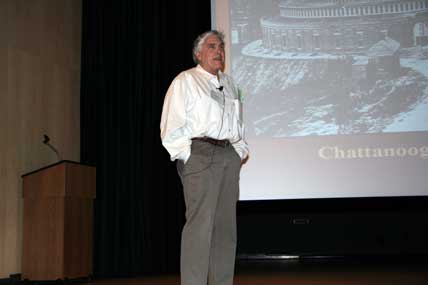 |
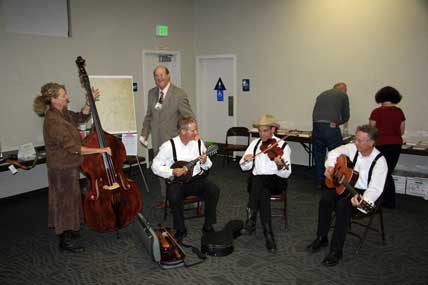 |
Wiley Sword |
Jim Stanbery |
Band for the social hour |
Jim Stanbery, a professor at Los Angeles Harbor College and a long time presenter at these West Coast conferences, gave a talk entitled The Cracker Line. Jim has an extraordinarily animated style of presentation, melding animated PowerPoint with music (including a group sing-along of Eating Goober Peas), and lots of shouting and dashing around the stage, leaving him out of breath at some points. I cannot say that this is my cup of tea, but I heard a number of appreciative laughs and positive comments from other members of the audience. Jim spent well more than half of the presentation talking about overall Civil War logistical issues, all of which were interesting, but overlapped a lot with Jim Ogden's presentation of the night before. He pointed out that Ulysses Grant intended to follow up Vicksburg with the drive toward Mobile and suggested that this strategy might have been more appropriate for the Union than what it eventually pursued. By concentrating all of its resources at Chattanooga, it merely ensured that the gateway into the Deep South was approached by the most difficult path available, through the mountains toward Atlanta. The remainder of Jim's presentation was about opening the Cracker Line (replacing the tenuous mountain supply lines into Chattanooga) through Brown's Ferry and the Battle of Wauhatchie.
 |
Evening Panel Discussion — Powell, Young, White, Robertson, Ogden, Jones, Sword, Stanbery |
Oddly, the conference was organized so that questions did not occur at the end of most individual presentations, but were ganged up. As the schedule started to slip, the opportunities for questions got squeezed out entirely, which is the only negative comment I will make about an otherwise well-organized conference. The joint question period for the afternoon was squeezed out and deferred to an evening panel discussion on The Importance of the Civil War's Western Theater, featuring all of the usual suspects, minus Steven Woodworth, but plus David Powell, who was not one of the regular speakers, but was the author of the newly released book on the Maps of Chickamauga. There were quite a few questions, but few on that topic and often not interesting to me, so I did not take extensive notes. The panelists were asked about the most valuable general and some of them assumed we were talking about these campaigns and others for the overall war, so the results were not scientifically accurate, but George H. Thomas seem to come out on top. There was an interesting discussion about the value of clearly written orders in the war and Dr. Robertson told an interesting anecdote about how orders are processed in the modern US Army. He said that Grant's orders to move down the western bank of the Mississippi in the Vicksburg campaign probably comprised 300 words, but in the modern Army a similar movement would occupy over 500 pages of orders. Then, those 500 pages would be condensed into a PowerPoint presentation and made almost incomprehensible to people outside the process. He said that is one of the challenges that modern military historians face—all of the cryptic Powerpoints and satellite e-mails that are used to conduct combat operations. There was a discussion of Sheridan that was generally negative, and someone said that he "marched away from the sound of the guns." Jim Ogden talked about the William Lytle monument on the Chickamauga battlefield, which has been stripped of most of its cannonballs, transforming the traditional pyramid for a fallen officer into a flat triangle. Jim says that the government, after 100 years, has just re-opened procurement of 8-inch iron naval shells that will be used to reconstruct the monument.
 |
The South Bay CWRT members in attendance (I thought that I was outside the frame, thus my goofy stance) |
Social events for the day included Civil War music and an excellent dinner banquet that included award presentations and raffle drawings, as well as a social hour down the street in another hotel that was scheduled for 9 PM to 1 AM and was fortified by all of the un-opened wines from dinner. Although the latter was an attraction for me, the late hours were not. :-)
Sunday, October 25
The final half day of the conference focused on the Chattanooga campaign. Jim Ogden gave a presentation on the Battle for Lookout Mountain. He opened by spending some time discussing the state of the CCNMP and pointed out that the park has been expanded from 8100 to 9000 acres in the last few years. Hamilton County, Tennessee, has a geographic information system database that has now been enhanced with historical battle information on a per-property basis. He told us about the process of evaluating public comments on battlefield preservation and indicated that the sheer volume of letters on one side of the issue or the other was the most important consideration, so he suggested that we should write to the superintendent about our thoughts on the upcoming revision of the general management plan for the battlefield, which will be similar to the efforts at Gettysburg to restore trees and fields to their historic conditions. He said that otherwise, the letters that advocate turning over land for soccer fields might comprise a higher stack. (Actually, I don't see why there would be a problem commemorating the locations in which the Union and Confederate soldiers played soccer.) He concluded by giving a good overview of the campaign plans for Chattanooga and spent a short amount of time on the battle itself, the "Battle above the Clouds."
Wiley Sword read a paper on the Battle for Missionary Ridge. Unfortunately, it overlapped some of Jim's campaign overview information. The actual description of the battle (Sherman at Tunnel Hill and Thomas on the center of the ridge) was relatively short and high level.
Lee white spoke on The Confederate Retreat and Battle of Ringgold Gap, which was a super detailed look at the battle action down to the regimental level. He made very effective use of photographs he took in the area as well as battle maps. I had not realized that there was so much action high on the ridges surrounding the gap.
Wiley Sword delivered the last presentation, The Consequences of the Campaign for Chattanooga, covering a number of topics about what happened after Chattanooga. He reported that Albert Castel said that George Henry Thomas should have been given command of the West instead of Sherman. Old Slow Trot would have taken Atlanta more quickly and efficiently than Sherman ended up doing. He described Bragg's resignation and the turmoil in the Army of Tennessee, which had shrunk into 40,000 men in January, plagued by desertions. He talked about William J. Hardee's petition to include blacks in the Army, primarily as laborers to free up white men as soldiers; the government responded they should spend more resources finding deserters from the Army, but went along with the proposal in a de facto sense. Pat Cleburne's proposal about arming blacks came later and effectively kept him from being promoted beyond division command. Wiley thought that Grant's elimination of prisoner exchanges was a an important factor in the end of the war. The loss of weapons during the rout on Missionary Ridge was a significant factor. And he said that the Atlanta campaign was not an anticlimax but that "the die had been cast."
We finished up a little early because some of the speakers had to be rushed to the airport, so I hit the road and made it home by midafternoon. Overall, the conference was a great experience and a testament to the hard work of the Civil War round tables in California. I am looking forward to attending the November 12-14, 2010, conference in San Francisco (about coastal fortifications and Alcatraz) and the November 11-13, 2011, in Sacramento (about the Civil War in 1861).
Blue and Gray Education Society Staff Ride of the Battle of Franklin, December 2-5
For my final Civil War trip of 2009, I have returned to middle Tennessee for a staff ride with the Blue and Gray Education Society on the Battle of Franklin. This is a sequel to an interesting visit last year at this time to the Battle of Spring Hill, a continuation of John Bell Hood's 1864 Tennessee campaign.
Wednesday, December 2
I flew to Nashville and then rented a car to get to Franklin, Tennessee, 20 miles south. We are close on the calendar to the climate of the actual battle, November 30, 1864. Today it's cold, windy, and rainy, but the forecast looks to be improving and it should simply be cold for the remainder of the trip. Fortunately, my mentor "Past Hal" provided me with the detailed notes about the discomfort of last year's trip and my lack of preparation, so this year I have ample, multiple layers in readiness for overnight lows of 20°.
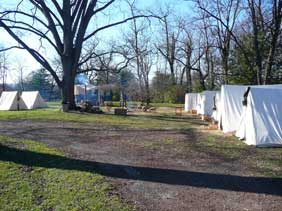 |
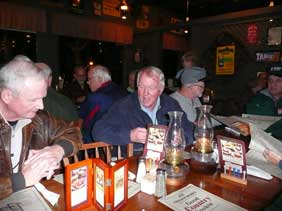 |
Our hotel accommodations |
Wild dinner at the Cracker Barrel |
We started off in the conference room of the Franklin Ramada Inn. Parker Hills, my friend and a veteran of these BGES staff rides, gave us an overview of Hood's campaign up through Spring Hill. He did one of his traditional animated PowerPoint presentations—a dog and pony show where the dog and pony actually move around with music and sound effects, so to speak—and I was happy to see that he is using a couple of my Wikipedia maps as part of his presentation. Of course, the first thing I noticed as he put it up on the screen was that I spelled one of the names wrong! It is remarkable that I looked at that map on my computer screen literally for hours and never noticed it. I asked a question about Thomas L. Connelly's interpretation of Spring Hill (in his two volume history of the Army of Tennessee) and Eric Jacobson, the author of the book For Cause and for Country and the primary historian on this trip, as he was last year, shot down old Tom's interpretation pretty decisively.
The group this year is rather larger—I think there are 22 people vs. a dozen last year—but it is good to see old friends from last year's conference as well as previous BGES trips. After Parker's overview, we drove over to Len Riedel's favorite restaurant for dinner. I think Len, the Big Kahuna of BGES, makes it a requirement that every hotel he books has to be within a few blocks of a Cracker Barrel restaurant. The food is good and plentiful, however, so I shouldn't be a San Francisco restaurant snob.
Thursday
The storm that blew through yesterday has blown away and today it's merely overcast, but rather cold. I went out dressed in layers and found myself comfortable until about noon, when it started to get really cold--upper 30s. That might not sound too cold, but there is a lot of time standing around outside relatively immobile in these affairs. I will be deploying additional layers tomorrow. I was lucky enough to once again achieve "daddy longlegs" status and receive the front seat in the van. For this expedition, we have two vans and Sam Hood's SUV, so everyone is a lot more comfortable than last year.
Since almost half of the current participants did not attend the previous year's session on the battle of Spring Hill, it was decided to do an on-scene recap and we spent most of the morning on that. So we drove south from Franklin and visited some of the highlights, starting at Weaver Hill, the scene of the most significant battling on November 29, 1864, where Patrick Cleburne's division attacked in the direction of Spring Hill, but was stopped before they were able to reach and block the Columbia Pike. That was the road that Maj. Gen. John M. Schofield was using to retreat from Columbia, and had the road been successfully blocked, a true disaster might have befallen the Union Army. So we spent some time not only looking at the ground but also discussing the command miscommunication between Hood and Frank Cheatham, which allowed the Union Army to sneak past the Confederates unharmed in the dead of night. From there, we drove to the water treatment plant on Rutherford Creek and saw where the Confederates crossed the creek, but possibly where one of the postbellum disputes between Hood and Cheatham occurred about whether you could see the Columbia Pike from Rutherford Creek or not.
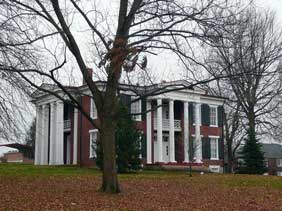 |
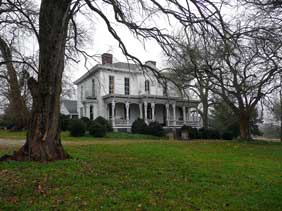 |
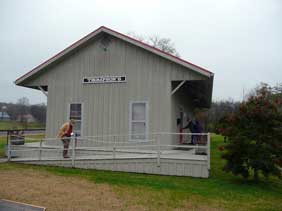 |
Cheairs mansion in Spring Hill |
Richard S. Ewell farm in Spring Hill |
Thompson's Station |
Then we visited some sites that we had lamentably skipped last year, including the ridge on which the Federal artillery was placed, blasting away at Cleburne's assault. I found from this visit that my recent Wikipedia map of the battle had the artillery placed incorrectly, a victim of conflicting books and Civil War atlases. (It is amusing that the Civil War Preservation Trust has published two maps on the battle and they conflict with each other.) I will get it fixed right away and do a general review of the map with Eric Jacobson. We prowled around the Martin Cheairs mansion, which was the building where Earl Van Dorn got killed for fooling around with a local man's wife. We returned to Rippavilla, the estate south of town where Hood had an angry breakfast meeting on November 30 with some of his generals, but we did not arrange to go inside the building. Another new spot for me was the railroad depot northwest of town. Emerson Opdycke's defensive line was near here, guarding in part a 50-acre holding area for over 800 supply wagons. Coincidentally, just across the tracks was the farm on which Richard S. Ewell retired after the war and the owners allowed us to enter their property and take photographs of the outside of the house.
Venturing into new territory, we drove north to Thompson's Station. This tiny town is famous for an 1863 battle fought by Nathan Bedford Forrest. It was the site of the death of his favorite horse, Roderick, and as we drove further north we saw a large statue of the horse located on the expansive property of the town's mayor. The station also figured in Hood's campaign when Sul Ross's Confederate cavalry briefly blocked the road to Franklin and had to be driven off by Union infantry. (Unfortunately for the Confederates, no one bothered to tell General Hood about this incident.) By then it was time for a delectable lunch at Subway in Franklin, just north of Winstead Hill. People who have been to the battlefield before were shocked to see so much development on the Columbia Pike in that area.
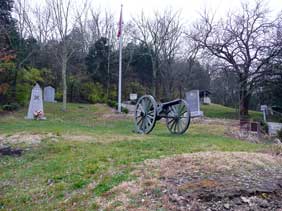 |
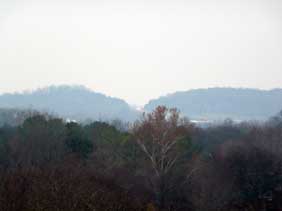 |
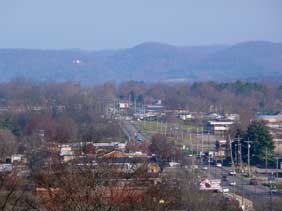 |
Winstead Hill park |
Winstead (right) and Breezy Hils |
View of Franklin from Winstead Hill |
After lunch we climbed Winstead Hill to visit the small Confederate veterans' memorial park and to see the vantage point that Hood had of the Union lines 2 miles to the north. Now there is more vegetation in the area and I found it rather difficult to see anything definitive, so I would have been reluctant to make command decisions based on that view. We spent some time talking about Hood's motivation to attack and, unlike the popular wisdom of Hood as a reckless and spiteful commander who sent his men to needless slaughter, we had to feel some empathy for him because he had essentially zero other options beyond letting Schofield escape entirely. Then we drove north to Fort Granger, the Union fortification northeast of Franklin, just over the river. Artillery placed here had devastating effect on the right flank of the Confederate assault, although I was surprised to hear that there were only four cannons involved. As it was approaching 4 p.m., the light was starting to dim, and we stopped to see the railroad bridge that Schofield had to repair. And then back to the hotel.
Thursday night was supposed to be on our own, but one of the local attendees, Darrell Moseley, invited us over to his apartment for wine and cheese before dinner. Darrell lives right in downtown Franklin, which is a delightful little town, in a building that has is African tribal art gallery downstairs and his apartment upstairs. The apartment is spectacular with hundreds of artistic pieces and artifacts from all over Africa and the Middle East. Darrell gave us a brief tour and commentary and it was astonishing how much detail he can remember about each piece. Someone remarked that he was the "Ed Bearss of anthropology." We were also impressed to browse through his personal Civil War Library, which contained many pristine copies of first editions of books most of us have only seen in reprints. We were all impressed with Darrell's copies and his generous hospitality. A few of us decided to go out to dinner and found that they roll up the sidewalks in Franklin pretty early, so we ended up near the hotel at a place called Franklin Chop House, which was casual, inexpensive, and pretty good.
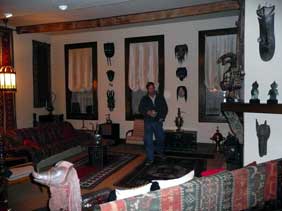 |
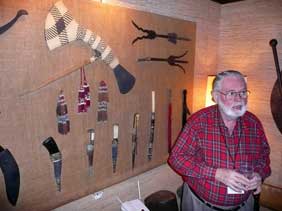 |
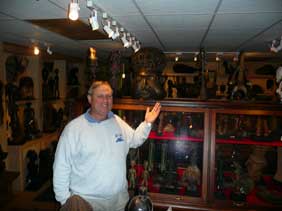 |
Sam Hood in Darrell's apartment |
Darrell Moseley |
Len Riedel in Darrell's shop |
Friday
Today we focused on the right side of the Confederate line (Stewart's corps). We started at the William Harrison house, just south of Winstead Hill, where Hood gave his battle orders to his corps commanders, and many of the division commanders were in attendance as well. We were not able to go into the house because its owner is, in some way unspecified, a little "eccentric." John C. Carter also died here when it was used as a field hospital after the battle. In discussing the meeting with Hood, Eric debunked the popular story that Nathan Bedford Forrest threatened Hood by saying something to the effect of "If you were not half a man, I would thrash you to within an inch of your life." Forrest was definitely not happy about the attack plan, but there is no documentation to support the story. (I do believe that the story about Forrest threatening Braxton Bragg on another occasion in a similarly lurid manner is actually true.)
We drove down Henpeck Lane to follow the route that Stewart's corps took to reach the Lewisburg Pike, outflanking the small Union force on Winstead Hill. I remarked to Len that most of us took Civil War tours primarily to avoid being henpecked! This intersection was the location of the first combat of the battle, a minor clash at 11 a.m. between Forrest's cavalry and Brig. Gen. John Croxton's. We stopped for coffee at the Henpeck Market, which is a colorful restaurant, grocery store, folk-artsy boutique, and gas station. We had a long discussion about whether Brig. Gen. John C. Brown was drunk at Spring Hill and the consensus seemed to be that there was insufficient evidence, but also "So what? Drinking habits were different in that era. And everybody was really cold." Spring Hill seem to continue to reach out to us from the depths of history and we had another discussion about who was responsible, eventually settling on Hood and all four of his corps commanders. (It is interesting to contemplate that the last battle Hood fought with his idol, Robert E. Lee, was marred by exactly the same circumstance—all four corps commanders let him down.)
We switched our focus to the Federal line on their left flank. Eric remarked that despite everyone blaming Hood for the failure at Franklin, he was actually defeated by the Federal Army more than by his own mistakes. We drove to a residential area, on a tiny street called Berry Circle, and examined the knoll from which the majority of the Union artillery fired on this end of the line. There were 10 guns that shot over 1,100 rounds for four hours, causing immense casualties to the approaching Confederates. (By contrast, the nearby Fort Granger had only four guns and shot about 170 rounds.) We drove to the intersection of the Lewisburg Pike and the railroad and saw where Union artillery blasted right down the railroad, preventing the Confederates from getting around the Union flank. We stopped briefly at the nearby Carnton plantation, where Eric is the historian, but because of timing reasons, we saw only the gift shop and museum in our morning visit. Then, by popular demand, we returned to the Henpeck Market for a very nice lunch.
After lunch we went to the area south of the main Union line where Brig. Gen. George D. Wagner's division was placed in an attempt to slow down the advance of the Confederates. The apex of the V-shaped Union position was at the Columbia Pike at about Carolyn Avenue. This was the most significant bonehead move that the Union Army made all day, the responsibility of David Stanley. ("Well, Stanley, that's another fine mess you've gotten us into.") These two brigades were quickly enveloped and overrun and while they frantically retreated back to the main line, the Union gunners were unable to fire at the closely pursuing Confederates, who ran right through an opening in the Union fortification. We will find out tomorrow what happened with that attack.
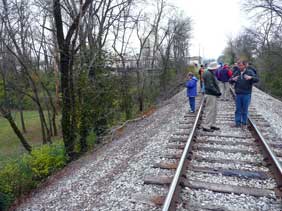 |
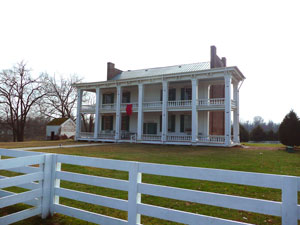 |
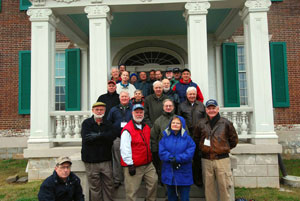 |
The railroad grade we ran up |
Carnton (back porch view) |
The group at Carnton (front) |
We drove back to the Confederate right and visited the small park known as the Collins farm (although Eric says that that is a postbellum name and therefore illegitimate, preferring the name "Assault on the Union Left"). Eric induced us to try running up the slope and then onto the railroad embankment. Fortunately, I was wearing good shoes and was not barefoot like some of the Confederates who had to do the same thing under fire. We drove to the corner of Adams and Cleburne Streets and discussed the death of Brig. Gen. John Adams. He charged the Union line mounted on his horse, Old Charley, and was shot multiple times and fell off. Charley continued to jump to the top of the breastworks, where he was unceremoniously killed with a bayonet. Contrary to the myth, Adams was not dragged into the Union lines to deliver a stirring statement about dying for his country. His body was found outside of the Union lines the next morning. (Eric is quite a myth buster.)
We returned to Carnton, where we took a group photo, and Eric showed us through the interior of the mansion. Unfortunately, it was late in the afternoon and the interior of the house was very dark. However, we were just able to see the blood stains in the wooden floors and noticed that one of the stains was exactly the shape that you would expect for the blood collecting around the feet of the surgeon. The story of Carnton is very moving—how the family was faced with 650 wounded men. Amazingly, the doctors were able to save 600 of them. We concluded our day by visiting the Confederate Cemetery next door, in which 1,481 are buried in a plot that has been maintained by the McGavock family since 1866.
In the evening, we had our group banquet at a restaurant called Famous Dave's Barbecue. I had Memphis style baby back ribs, a delicacy I first encountered in Memphis with the Civil War Preservation Trust, and this version was really excellent.
Saturday
Our final day concentrated on the Confederate left (Cheatham et al.). Once again we started at Winstead Hill, only this time the weather was sunny and clear, so we had a much better view of the 2 miles toward the Union lines. We discussed the approach of the units on the Confederate left and quickly returned to downtown. We started at the site of the Carter cotton gin, which is now occupied by a small blue house. The Franklin preservation group owns the property and is planning to move the building or tear it down and replace it with a reconstructed version of the gin building, one of the most important landmarks on the battlefield. Eric has a whole wish list of improvements and acquisitions that he wants to make, and probably the most compelling is to remove a small shopping center with a Domino's Pizza that is directly north of the former Pizza Hut, which was demolished in 2005 to commemorate the death of Patrick Cleburne. (I saw the rubble of that store when I visited Stones River.) Unfortunately, they want about $1.5 million for the property.
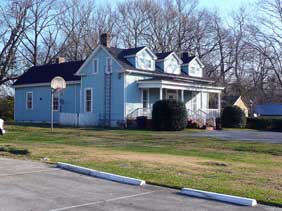 |
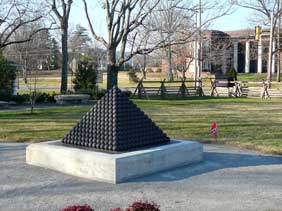 |
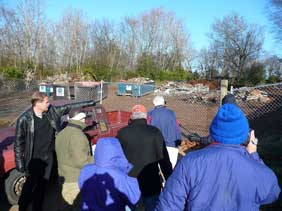 |
House on the site of the Carter cotton gin |
Monument to Patrick Cleburne |
Carter Gardens |
We walked a few blocks to the site of the Carter Gardens, which was recently acquired, but is still in disrepair with large piles of rubble. Eric plans to have that entirely cleaned up in a couple of months, extending the area of interpretation for the Carter House site. We discussed the location and nature of the Union line in this area. The formidable earthworks that were erected the morning of November 30 had a gap where the Columbia Pike passed through, so that Union wagons could proceed north. As a partial means of protecting this opening, slightly behind the line there was something called the "retrenchment," which was meant to be more of a 125 foot barrier than a protected firing location. When the wagons went through the opening in the main line, they had to detour around this barrier. There was also artillery pointed at the opening. We traveled a couple of hundred yards north, over the slight hill on which the Carter House is located, to the place where Emerson Opdycke's brigade was in reserve, which is now a small shopping center. The interesting thing about his position is that his regiments were stopped in column, facing north; they had been the rearguard for the last couple of days, pressured almost nonstop by Hood's army, and were anxious to withdraw to Nashville as soon as possible.
We walked over to the Carter House museum and gift shop for a bathroom break. I examined a large diorama of the battle and found quite a number of inaccuracies. (My wife Nancy knows that I take special pride in finding mistakes!) Outside of the visitor center we surveyed the area defended by the 111th Ohio, which is currently represented by a terraced landscape. We found out that this was engineered to provide bleacher seating for the Franklin Rodeo, but that Eric has plans to restore it to its natural slope. We returned to the cotton gin to talk about Patrick Cleburne. After a couple of his horses were disabled, Cleburne proceeded on foot and was quickly felled by numerous gunshot wounds. The pyramid monument recently erected on the Pizza Hut site is not intended to represent the exact point of his death, but merely to be a generic memorial. The Confederates actually came pretty close to breaking through the line at the cotton gin, dislodging two unlucky Ohio regiments, but they were repulsed by 4 guns of Lt. Aaron Baldwin's 6th Ohio battery, which fired over 400 rounds against Cleburne's division and Francis M. Cockrell's brigade. The Union line was stabilized east of the pike and the Confederates were not able to break through or hold any of the line there. This was due to a strong counterattack by two Kentucky regiments and three regiments from Opdycke's brigade.
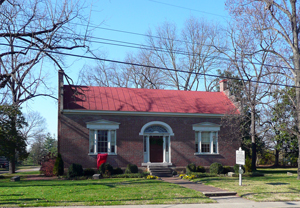 |
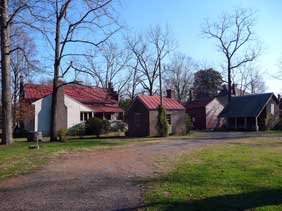 |
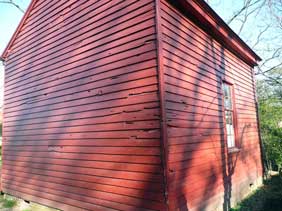 |
Carter House (front) |
Carter House (rear) |
Bullet holes in Carter building |
Back at the Carter House, Eric described the point just north of the house as the "high water mark" of the Army of Tennessee. Here the Confederates made a significant breakthrough, but they were counterattacked by units including the other half of Opdycke's brigade. (Opdycke invested a lot of time in self-promotion after the war, making it seem as if his brigade were the only force that kept the Union line from collapsing, although Eric was able to identify a number of other units that played crucial roles together with them. Eric debunked the popular story about Opdycke fighting Confederates soldiers with the butt of his pistol, saying that he actually had a musket, which he used primarily to prod his own soldiers into action.) The fighting as described was unbelievably brutal and desperate, with many hand-to-hand encounters.
We walked down the long slope below the visitor center to see the site of the assaults by William B. Bate and Edward "Allegheny" Johnson, both of which failed pretty miserably. We went into the Carter House itself briefly, but started running into time pressure. In the last few minutes before our adjournment, we jumped into the vans to go farther west on the Union line, hoping to find the location of Battery B, Pennsylvania Light Artillery, but we ran into blocked streets for the annual Christmas parade and had to give up on our objective.
After returning to the hotel and saying goodbye to the group, my friend Harry and I decided to find that artillery location and got some directions from Eric. We found it just a few blocks from the Carter House in the rear of a vacant mortuary. We could just make out the general form of the Union line, but it was rather difficult because of the trees and houses in the way. We also visited the supposed location of Union breastwork remnants near the Carter Creek Pike, which was in somebody's yard, but they were not really noticeable. We were able to find the end of the Union line, where it connected to a sharp bend in the Harpeth River northwest of town. We finished the day in downtown Franklin at the Mellow Mushroom pizza restaurant, which was very good.
To sum things up: I had an outstanding time on yet another Blue and Gray excursion. Eric Jacobson was really excellent and insightful. I would say that the biggest misconception I had about the battle was the popular wisdom that Hood's assault was essentially suicidal. (I had already discounted the alleged factor of him trying to punish his troops using this method.) Walking the ground and hearing the detailed explanations of unit actions made it pretty clear that Hood came very close to succeeding, that about 200 yards of the Union line was broken and the possibility of the Union Army being routed was very real. Only good luck and truly valiant, fierce defensive actions by Union artillery and infantry defeated Hood. This assault is frequently compared to the smaller Pickett's Charge at Gettysburg, but Eric portrayed that assault as one that was doomed from the start, whereas this one had an actual chance of success. Well, there was a second misconception, too—that the Franklin battlefield was irretrievably lost. Now I see that you can interpret a great deal of this battle after all and that there are plans underway to make big improvements. Bravo!
The third Blue and Gray session on Hood's campaign will be next December, concerning the Battle of Nashville. I don't know whether I will be able to attend that or not and will wait for the published itinerary before deciding. In the meantime, I hope everyone has a Merry Christmas and Happy New Year. I have done very little planning for Civil War traveling in 2010. My only current commitment is in conjunction with running the Atlanta Marathon in March and I will be flying out a couple of days early in the hopes of seeing some interesting Atlanta battlefields.